Buying hair extensions is one thing. Keeping them looking fresh, natural, and last for months? That’s another story. If you’ve ever seen your extensions tangle up after a week, turn dry and frizzy by day ten, or worse-fall out prematurely-you know how easy it is to mess up. The good news? With the right routine, your extensions can last 6 to 12 months, even with daily wear. It’s not about spending hours in front of the mirror. It’s about doing the right things, consistently.
Wash Them Less Than You Think
Most people wash their extensions every other day, thinking it keeps them clean. That’s the fastest way to kill them. Hair extensions don’t get oil from your scalp like your natural hair does. They’re already processed, and overwashing strips away the natural oils and protective coatings that keep them soft and shiny.Wash them only once a week, or every 10 days if you’re not sweating a lot or using heavy products. If you’re active, rinse with water after workouts and skip the shampoo. Use a sulfate-free, moisturizing shampoo designed for extensions. Gently massage it into the hair, starting from the mid-lengths down to the ends. Never scrub the bonds or clips-those areas are fragile.
Always rinse with cool water. Hot water opens the cuticle, makes the hair porous, and leads to faster fading and frizz. After washing, gently squeeze out water with your hands. Don’t wring or twist. Lay the extensions flat on a towel and roll them up to soak up excess moisture.
Never Sleep With Wet Extensions
Sleeping with damp extensions is one of the top reasons people end up with matted, damaged hair. Wet hair is at its weakest point. When you toss and turn, the strands rub against each other and the pillow, causing breakage, knots, and even shedding at the roots.Always dry your extensions completely before bed. Use a blow dryer on low heat and a diffuser, or air-dry them overnight if you’re not in a rush. If you’re short on time, loosely braid or tie them in a loose ponytail before sleeping. This keeps them from tangling. Use a silk or satin pillowcase-it reduces friction and helps retain moisture.
Brush Gently, Every Day
Brushing isn’t optional. It’s essential. But doing it wrong can rip out strands or snap bonds. Use a wide-tooth comb or a brush made specifically for extensions-like a Tangle Teezer or a detangling brush with flexible bristles.Start from the bottom. Hold the hair just above the weft or clip to keep tension off the attachment points. Slowly work your way up in small sections. Don’t pull through knots with force. Spray a light detangler or leave-in conditioner on the ends first. If you skip brushing, knots will form overnight and turn into tangles you can’t fix without cutting.
Always brush before washing and before bed. Even if your extensions look fine, brushing them daily prevents buildup and keeps them smooth.
Avoid Heat Without Protection
You can style your extensions with curling irons, flat irons, and blow dryers-but only if you protect them. Most extensions are made from human hair, but they’ve already been treated, colored, and processed. That means they’re more sensitive to heat than your natural hair.Always use a heat protectant spray before styling. Set your tools to no higher than 350°F (175°C). Anything above that risks melting the cuticle, causing brittleness and split ends. If you’re using a flat iron, go slowly and pass over each section just once. Repeated passes = more damage.
Also, avoid direct heat on the bonds or tape. The glue or adhesive can melt, and that’s when extensions start slipping. If you’re unsure, stick to heatless styles: braids, buns, or overnight rollers.
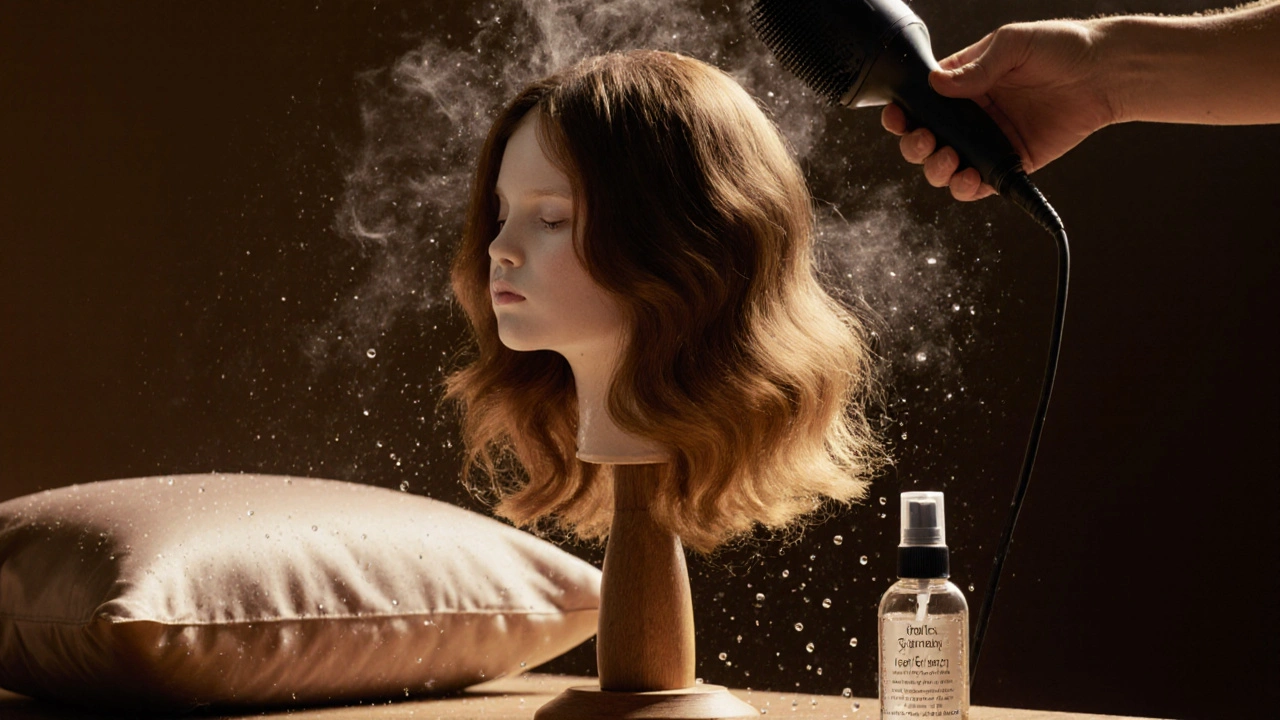
Keep Them Away From Chlorine and Saltwater
Swimming in the pool or ocean can ruin your extensions fast. Chlorine dries out the hair, and saltwater leaves mineral deposits that make it stiff and brittle. If you’re going swimming, put your hair in a tight bun or wear a swim cap. If you forget and get wet, rinse your extensions immediately with fresh water after getting out.Follow up with a deep conditioning treatment. Use a mask with shea butter, argan oil, or keratin once a week. Leave it on for 20 minutes, then rinse with cool water. This restores moisture and keeps the hair flexible.
Store Them Right When Not in Use
If you take your extensions out at night or between uses, don’t just toss them in a drawer or a plastic bag. That causes tangling and flattens the curls or waves.Hang them on a hook or lay them flat on a wig stand. If you don’t have one, roll them loosely around a cardboard tube (like a paper towel roll) and secure with a hair tie. Keep them in a cool, dry place away from direct sunlight. UV rays fade color and dry out the hair over time.
Never store them while wet. Moisture trapped in a bag leads to mold, mildew, and odor. Always dry them completely before putting them away.
Don’t Use the Wrong Products
Not all hair products are safe for extensions. Avoid anything with alcohol, sulfates, or heavy oils like coconut oil or castor oil. Alcohol dries out the hair. Sulfates strip color and texture. Heavy oils weigh down the hair and can loosen clips or bonds.Stick to lightweight serums, leave-in conditioners, and extension-specific sprays. Look for ingredients like hyaluronic acid, panthenol, and ceramides-they hydrate without buildup. Avoid dry shampoo unless it’s labeled for extensions. Most dry shampoos leave a chalky residue that builds up and makes hair look dull.
Also, skip hair masks with protein overload. Too much protein makes extensions stiff and prone to snapping. If your extensions feel rough or brittle, you’ve likely used too much protein. Switch to a moisturizing mask instead.
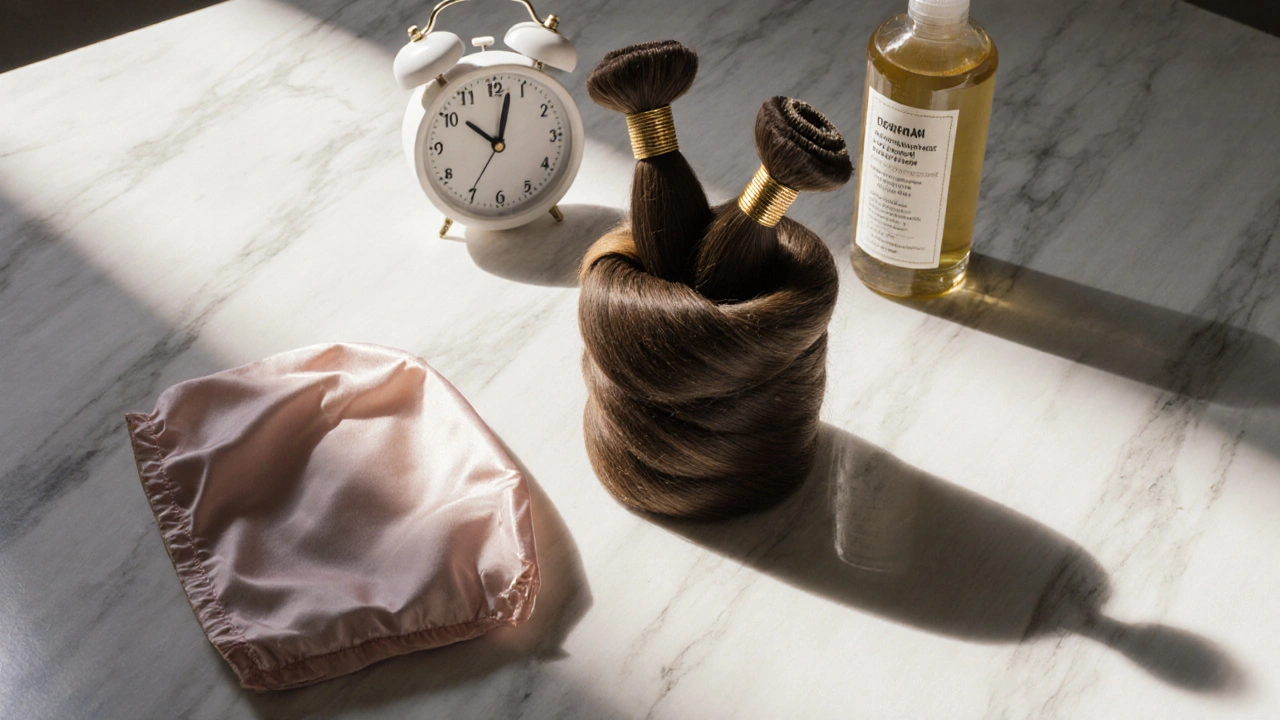
Check the Bonds Weekly
Whether you have tape-ins, sew-ins, or clip-ins, the attachment points need attention. For tape-ins, check for lifting edges every 7-10 days. If you see glue peeling, gently clean the area with an oil-based remover (like coconut or olive oil) and re-tape. Don’t wait until they fall out.For clip-ins, inspect the clips for bent teeth or loose screws. Tighten them with a small screwdriver if needed. For sew-ins, make sure the braids underneath aren’t loosening. If you feel tension or see your natural hair pulling, see a stylist right away.
Regular maintenance prevents sudden damage. A quick 5-minute check once a week saves you from a costly repair or replacement.
When to Replace Them
Even with perfect care, extensions don’t last forever. Signs it’s time to replace them:- Significant shedding-more than 10-15 strands per wash
- Extreme tangling that won’t come out, even after conditioning
- Color fading or turning brassy, especially if you’ve dyed them
- Hair feels dry, straw-like, or snaps easily when brushed
- Bonds or clips no longer hold securely
If you’ve had them for over a year, it’s probably time for a new set. High-quality human hair extensions can last up to 12 months with care, but most people get 6-8 months of good use before they start looking worn.
Don’t try to stretch them beyond their limit. Damaged extensions look unnatural and can pull on your natural hair, leading to breakage or traction alopecia.
Can I use regular shampoo on hair extensions?
No. Regular shampoos contain sulfates and harsh detergents that strip moisture and color from extensions. Always use sulfate-free, moisturizing shampoo made for extensions. It’s gentler and helps them last longer.
How often should I wash my hair extensions?
Once a week is ideal. If you’re not sweating much or using products, you can stretch it to every 10 days. Overwashing causes dryness and shortens their lifespan. Rinse with water after workouts instead of shampooing.
Can I sleep with my hair extensions in?
Yes-but only if they’re completely dry. Wet extensions tangle and break easily. Always dry them fully before bed, and sleep on a silk pillowcase. Braiding them loosely also helps prevent knots.
Do I need special brushes for extensions?
Yes. Use a wide-tooth comb or a brush designed for extensions, like a Tangle Teezer. Regular brushes can snag and pull. Always start brushing from the ends and work your way up slowly.
Can I swim with hair extensions?
You can, but it’s risky. Chlorine and saltwater dry out the hair and cause buildup. If you swim, wear a swim cap or rinse the extensions with fresh water immediately after. Follow up with a deep conditioner to restore moisture.
Why are my extensions getting tangled so fast?
Tangling usually means you’re not brushing daily, washing too often, or using the wrong products. Also, sleeping with wet hair or using heavy oils can cause knots. Stick to a weekly wash, daily brushing, and lightweight conditioners.
How long do hair extensions last?
With proper care, high-quality human hair extensions last 6 to 12 months. Most people get 8 months of good use. If they start shedding heavily, feel brittle, or look dull, it’s time to replace them.
Final Tip: Treat Them Like Your Own Hair
The best way to care for extensions is to think of them as an extension of your natural hair-because they are. They need moisture, protection, and gentle handling. Don’t treat them like disposable accessories. The more you respect them, the longer they’ll look beautiful and blend naturally with your own hair.It’s not about perfection. It’s about consistency. Brush daily. Wash weekly. Dry before bed. Protect from heat and water. Check the bonds. That’s it. Do those things, and your extensions will keep looking fresh for months-not days.

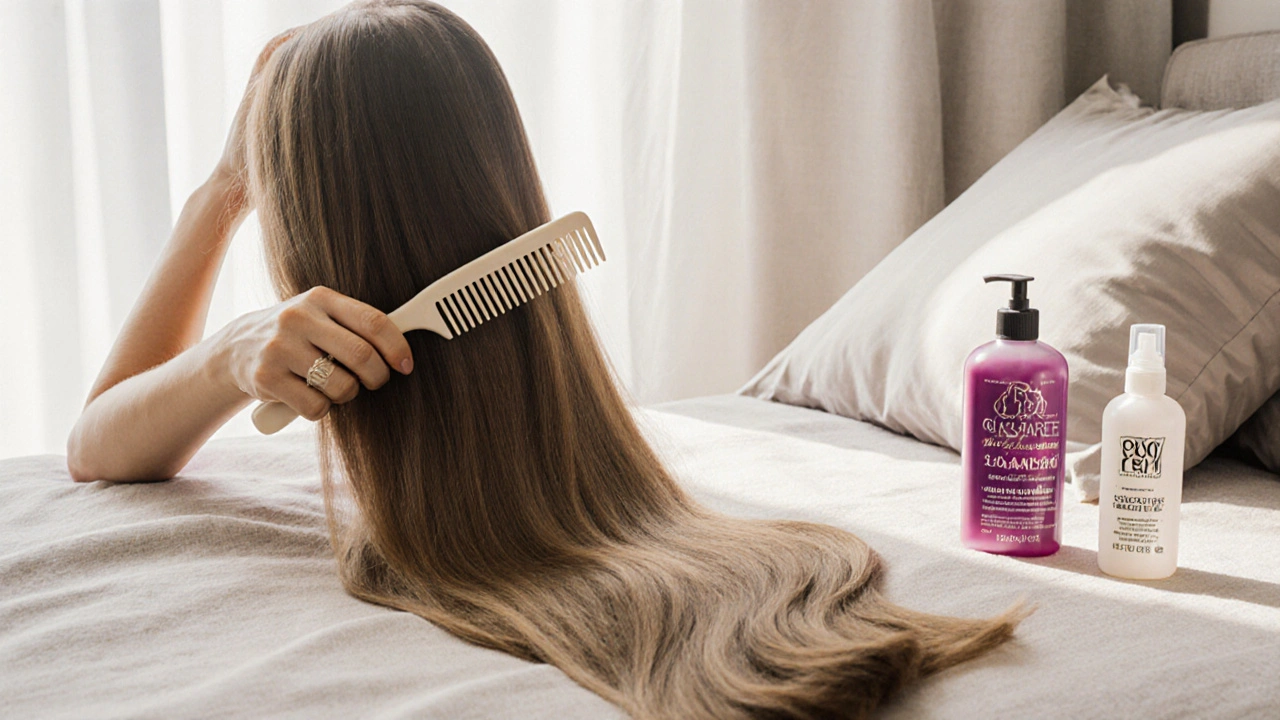

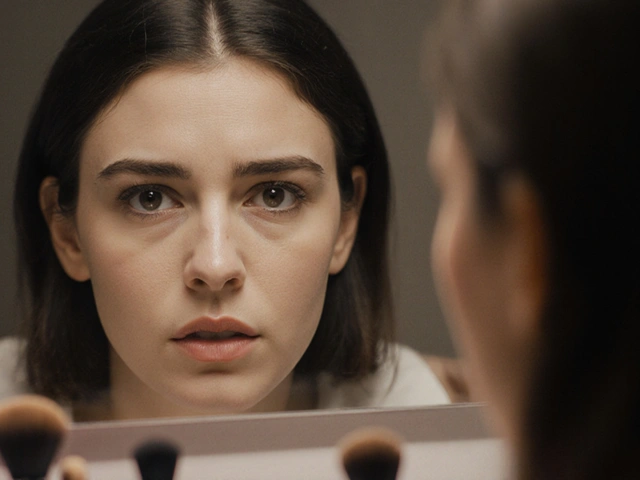


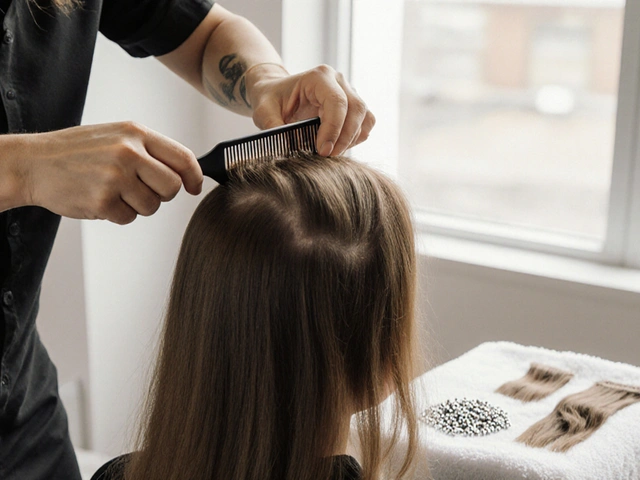
Yashwanth Gouravajjula
October 29, 2025 AT 01:25From India, we use coconut oil on everything-including extensions. But yeah, you’re right-too much weighs it down. Learned that the hard way. Stick to argan. Works better.
Janiss McCamish
October 30, 2025 AT 21:16Brushing daily is non-negotiable. Skip it once and you’re begging for knots.
Andrew Nashaat
November 1, 2025 AT 04:58Wow. Just... wow. You actually took the time to write a 2000-word essay on hair extensions? I mean, I get it, but come on. Do you also have a 12-step program for not dropping your phone? Sulfate-free shampoo? Please. I wash mine with dish soap and it’s fine. Who even made these rules? Some corporate salon puppet?
Eric Etienne
November 3, 2025 AT 04:39Bro. I’ve had extensions for 3 years. I sleep with them wet, brush them with a paddle brush, wash them every 2 days, and use heat on 450. They still look fine. Maybe you’re just bad at life.
Gina Grub
November 4, 2025 AT 14:54Let’s be real-extensions are a liability. A beautiful, expensive, high-maintenance liability. You’re not caring for hair. You’re managing a fragile ecosystem of processed keratin and corporate marketing. The fact you’re even reading this means you’ve already lost.
Amanda Ablan
November 5, 2025 AT 22:18For anyone new to extensions: start slow. Don’t try to do everything at once. Brushing daily is the easiest win. And silk pillowcase? Game changer. I used to wake up with a bird’s nest. Now? Smooth. Just try it for a week.
Pamela Tanner
November 7, 2025 AT 17:27It is imperative to note that the use of sulfates in shampoos induces cuticular degradation in both natural and extended hair fibers. Furthermore, the application of heat exceeding 175 degrees Celsius results in irreversible denaturation of keratin proteins. Adherence to the prescribed regimen is not optional-it is scientific.
Meredith Howard
November 8, 2025 AT 18:40Why is it always about washing less? What if I sweat a lot? What if I live in a humid city? What if my extensions smell after a week? Nobody talks about the smell. Just saying.
Dylan Rodriquez
November 9, 2025 AT 15:50It’s funny how we treat hair extensions like they’re fragile art pieces. But they’re just hair. Human hair. It’s alive, in a way. It remembers how you treat it. Treat it with care, it gives you years. Treat it like trash, it turns to straw. Maybe the real lesson isn’t in the steps-it’s in the respect.
Kendall Storey
November 9, 2025 AT 21:46Low-key the biggest flex is having extensions that still look good after 8 months. Not the fact you bought them. Not the price tag. The fact you didn’t ruin them. That’s discipline. That’s power.
Ashton Strong
November 10, 2025 AT 15:49Thank you for this comprehensive and thoughtful guide. Many individuals overlook the importance of consistent maintenance, and your attention to detail reflects a deep understanding of hair science and aesthetics. I appreciate the emphasis on hydration and structural integrity.
Kevin Hagerty
November 11, 2025 AT 01:54Wash once a week? Are you kidding me? I’m not a robot. I go to the gym. I sweat. I live. I don’t care if my extensions look like they’ve been dragged through a dryer full of cat hair. They’re still hotter than your life. Also I use dry shampoo 3x a day. Suck it.
Steven Hanton
November 12, 2025 AT 02:01I’ve been using clip-ins for five years. The biggest mistake I made? Buying cheap ones. Once you invest in 100% Remy human hair, everything else becomes easier. The care routine doesn’t change-but the results do. Worth every penny.
Richard H
November 13, 2025 AT 00:14Why are we even talking about this? In America, we don’t coddle our hair. We own it. If your extensions fall out, you didn’t work hard enough. No one in my neighborhood uses silk pillowcases. We use cotton and pray.
Sandy Pan
November 15, 2025 AT 00:11There’s a deeper truth here: we don’t just care for extensions because we want them to last. We care for them because they’re a version of ourselves we’re trying to hold onto. The way we treat them reflects how we treat our own identity-fragile, temporary, and in need of constant gentleness. Maybe that’s why we’re so obsessive. Not about hair. About belonging.